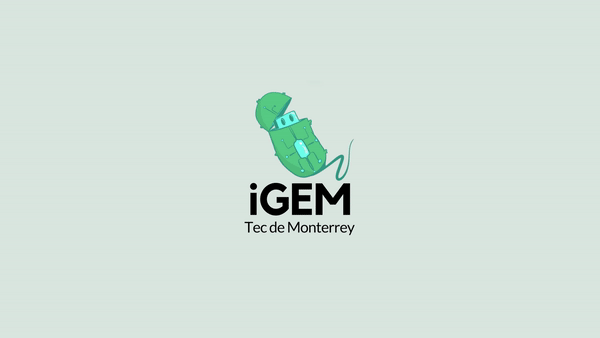EstebanDLPT (Talk | contribs) m |
EstebanDLPT (Talk | contribs) m |
||
| Line 56: | Line 56: | ||
CRISPR-Cas technology has the capability of storing information. This year, iGEM team Tec-Monterrey aims to use the CRISPR-Cas system to store specific DNA sequences in the genome of E. coli in order to save information about the environment surrounding the bacteria. To make this possible, Cas1-Cas2 proteins, which create the protospacer acquisition in the CRISPR system, are used to insert a synthetic DNA sequence in the CRISPR array within the genome of the bacteria. This synthetic sequence is produced by a second system, called SCRIBE. The final step of our project is reading out the inserted DNA sequence. Specific primers for polymerase chain reaction (PCR) are used to amplify a section of the CRISPR array where the sequence is inserted. Taking together both systems, our project intends to act as a biological tape recorder capable of sensing external stimuli in the environment and storing their presence in the genome. | CRISPR-Cas technology has the capability of storing information. This year, iGEM team Tec-Monterrey aims to use the CRISPR-Cas system to store specific DNA sequences in the genome of E. coli in order to save information about the environment surrounding the bacteria. To make this possible, Cas1-Cas2 proteins, which create the protospacer acquisition in the CRISPR system, are used to insert a synthetic DNA sequence in the CRISPR array within the genome of the bacteria. This synthetic sequence is produced by a second system, called SCRIBE. The final step of our project is reading out the inserted DNA sequence. Specific primers for polymerase chain reaction (PCR) are used to amplify a section of the CRISPR array where the sequence is inserted. Taking together both systems, our project intends to act as a biological tape recorder capable of sensing external stimuli in the environment and storing their presence in the genome. | ||
</section> | </section> | ||
| + | |||
| + | <div class="body-title">System Functionality</div> | ||
<section class="container-description"> | <section class="container-description"> | ||
| Line 67: | Line 69: | ||
<ul> | <ul> | ||
<li> | <li> | ||
| − | A | + | A reverse transcriptase protein |
</li> | </li> | ||
<li> | <li> | ||
| Line 73: | Line 75: | ||
</li> | </li> | ||
<li> | <li> | ||
| − | + | A second RNA moiety, called msd, which represents a template for the reverse transcriptase. This sequence contains the message of interest. | |
</li> | </li> | ||
</ul> | </ul> | ||
Revision as of 19:15, 17 October 2018

System Functionality
Construct that codes for the SCRIBE system adaptation.
This system generates single-stranded DNA inside of living cells in response to gene regulatory signals.
It is composed of 3 main components:
This system generates single-stranded DNA inside of living cells in response to gene regulatory signals.
It is composed of 3 main components:
- A reverse transcriptase protein
- One msr RNA moiety which acts as a primer for the RT.
- A second RNA moiety, called msd, which represents a template for the reverse transcriptase. This sequence contains the message of interest.







References
Amlinger, L., Hoekzema, M., Wagner, E. G. H., Koskiniemi, S. & Lundgren, M. Fluorescent CRISPR Adaptation Reporter for rapid quantification of spacer acquisition. (2017).doi: 10.1038/s41598-017-10876-z.
Díez-Villaseñor, C., Guzmán, N. M., Almendros, C., García-Martínez, J. & Mojica, F. J. M. CRISPR-spacer integration reporter plasmids reveal distinct genuine acquisition specificities among CRISPR-Cas I-E variants of Escherichia coli. RNA Biol. (2013). doi:10.4161/rna.24023
Farzadfard, F., & Lu, T. K. Genomically encoded analog memory with precise in vivo DNA writing in living cell populations. Science. (2014). doi: 10.1126/science.1256272.
Levy, A., Goren, M. G., Yosef, I., Auster, O., Manor, M., Amitai, G., Edgar, R., Qimron, U. & Sorek, R. CRISPR adaptation biases explain preference for acquisition of foreign DNA. Nature. (2015). doi:10.1038/nature14302
Nuñez, J. K. Mechanism of CRISPR–Cas Immunological Memory. (2016). Doctoral dissertation, UC Berkeley
Nuñez, J. K., Kranzusch P, Noeske J, Wright A, Davies C, Doudna J. Cas1-Cas2 complex formation mediates spacer acquisition during CRISPR-Cas adaptive immunity. Nat. Struct. Mol. Biol. (2014). doi:10.1038/nsmb.2820
Sheth, R. U., Yim, S. S., Wu, F. L. & Wang, H. H. Multiplex recording of cellular events over time on CRISPR biological tape. Science. (2017). doi:10.1126/science.aao0958
Shipman, S. L., Nivala, J., Macklis, J. D., & Church, G. M. Molecular recordings by directed CRISPR spacer acquisition. Science. (2016). doi: 10.1126/science.aaf1175
Tang, W., & Liu, D. R. Rewritable multi-event analog recording in bacterial and mammalian cells. Science. (2018). doi: 10.1126/science.aap8992


